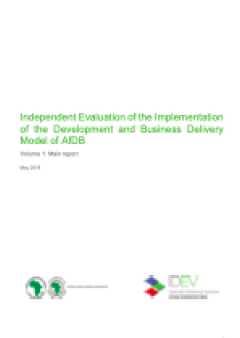
Independent Evaluation of the Implementation of the Development and Business Delivery Model of the AfDB
In 2016 the Bank decided to focus on five priority objectives, the “High 5s”: Light Up and Power Africa; Feed Africa; Industrialize Africa; Integrate Africa; and Improve the Quality of Life for Africans. At the same time, the Bank redesigned its operational model, organizational structure and pricing framework (together called the Development and Business Delivery Model, or DBDM). The DBDM focuses on five institutional pillars: (i) Move closer to the client to enhance delivery; (ii) Reconfigure headquarters to support the regions to deliver better outcomes; (iii) Strengthen the performance culture to attract and maintain talent; (iv) Streamline business processes; and (v) Improve financial performance and increase development impact.
The primary purpose of the evaluation was to take stock of and assess the implementation of the DBDM, in order to inform discussions in the context of the replenishment process for the African Development Fund (ADF) and the General Capital Increase (GCI) of the Bank. The evaluation will also inform further implementation of the DBDM itself and any additional reform efforts.
The evaluation focused, to the extent possible, on the following questions:
- To what extent have reforms in the five pillars been implemented as conceived/planned?
- To what extent have the reforms increased the Bank Group’s capacity to deliver on its objectives?
- What have been the key challenges for implementing reforms in each pillar and what are the lessons to improve the development effectiveness of the reforms?
- Are there unexpected consequences and effects?
The evaluation selected a sample of reforms within each of the DBDM’s five pillars for examination. In total, 18 reform initiatives comprising 43 specific elements were examined. Of the 43 reforms, 10 have been fully completed or are near completion, 13 are ongoing, and 20 need immediate attention to either initiate or accelerate.
The overall conclusions of the report indicate an ambitious Bank, making strides in its reform agenda, but also facing challenges. The evaluation found that while reforms were well identified, the ambition of the proposed transformation was over-optimistic given the context, the Bank’s history, and its capacity and capability to manage significant change, as well as deliver its core mandate. However, the report notes that implemented reforms have already resulted in positive change, and there is considerable potential for further benefits if the full reform package is well implemented.
The strategic recommendations of the evaluation include :
- Paying critical attention to how change is managed through the establishment of a clear change management structure.
- Putting in place a clear implementation plan and results matrix for the remaining or any new reforms, including systematic and transparent reporting to ensure oversight, both from Bank Management and from the Board of Directors.
- Reviewing existing timelines and establishing clear timelines where there are none with due regard to feasibility.
- Reviewing Key Performance Indicators (KPIs), in particular, the joint KPIs. KPIs can be both an incentive and a disincentive; proper analysis is needed to ensure that they have the effect aimed for.
The evaluation was presented to and welcomed by the Board of Governors at the Bank’s Annual Meetings in June 2019, and has informed the recently concluded General Capital Increase discussions.
